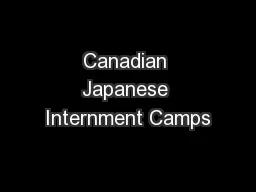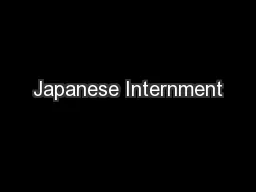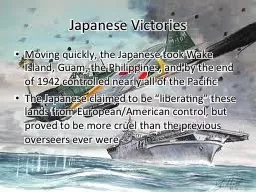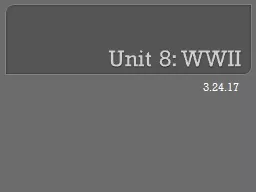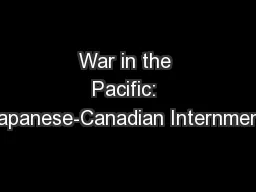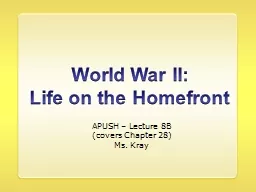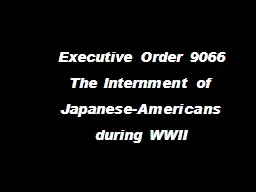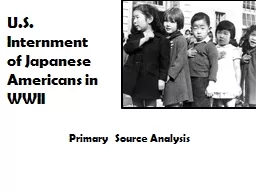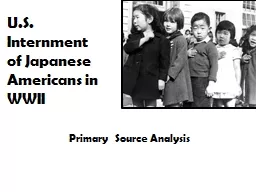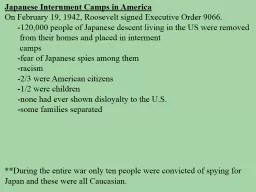PPT-Canadian Japanese Internment Camps
Author : kittie-lecroy | Published Date : 2018-10-14
War on the Home front QUESTION 1 What is more important to you Civil liberties democracy individual freedoms rights etc OR National Security QUESTION 2 Would this
Presentation Embed Code
Download Presentation
Download Presentation The PPT/PDF document "Canadian Japanese Internment Camps" is the property of its rightful owner. Permission is granted to download and print the materials on this website for personal, non-commercial use only, and to display it on your personal computer provided you do not modify the materials and that you retain all copyright notices contained in the materials. By downloading content from our website, you accept the terms of this agreement.
Canadian Japanese Internment Camps: Transcript
War on the Home front QUESTION 1 What is more important to you Civil liberties democracy individual freedoms rights etc OR National Security QUESTION 2 Would this change during war Why or why not. World War I. The Background. 171,000 people in Canada were citizens of countries considered enemies of Canada. Many were second-generation and spoke English as their primary language. 80,000 of them were forced to register with the police and report on a regular basis. Canada. Grocery store owned by K. . Odaka. , ravaged by protesters during anti-Asian protests, 1907. Japanese Internment. After the attack on Pearl Harbor, December 7, 1941, a racist campaign was launched against Japanese citizens living in North America, particularly ones residing on the Pacific Coast.. 5. th. . Grade. Japanese Internment Camps. In . 1942, . over 127,000 people were forced to leave their homes and go to the . J. apanese internment camps.. The camps were built in . unbearably . hot places, such as deserts and California, to torture the . Moving quickly, the Japanese took Wake Island, Guam, the Philippines, and by the end of 1942 controlled nearly all of the Pacific . The Japanese claimed to be “liberating” these lands from European/American control, but proved to be more cruel than the previous overseers ever were. “Consider why Germany, fighting a war on two . fronts, desperate . for fuel and materiel of every sort, would . bother to . load millions of Jews on railroad cars and . transport them . hundreds, even thousands, of miles to . America’s Humiliation: Japanese Internment Camps. Western Defense Command and Fourth Army Wartime Civil Control Administration (May 3, 1942). Freedom. Responsibility, and Justice. Page 181-182. Civilian Exclusion Order No. 5. 3.24.17. Timeline. Review the major events of Japanese-American internment & . talk with . your row. :. What do you know about Japanese-American internment?. What surprises you about the timeline?. & The Atomic Bombs. Internment Camps. War Measures Act. : waiving of habeas corpus and right to trial, bans on political and religious groups, restrictions of free speech, confiscation of property and…. APUSH – Lecture 8B. (covers Chapter 28). Ms. Kray. Mobilizing for a Total War. Industrial Production. “. War is no longer simply a battle between armed forces in the field. .”. Another total war . Japanese-Americans . during WWII. FDR orders the relocation of people of Japanese descent from the west coast to temporary camps in the interior of the country for national security. .. Over 120,000 people were imprisoned . Are racial stereotypes essential for our protection, or an example of our ignorance? . Japanese American Internment. Background Details. Executive Order 9066. Issued by FDR in February 1942. Relocated nearly 120,000 Japanese Americans – 62% of whom were American citizens. Americans in. WWII. Primary Source Analysis. in·tern·ment. . n. .. . 1. . The act of interning or confining, especially in wartime.. 2. . The state of being interned; confinement. Public notices were posted announcing that all Japanese Americans – even those with as little as 1/16th Japanese blood – had 48 hours to sell their property and possessions and gather at assembly points. . Americans in. WWII. Primary Source Analysis. in·tern·ment. . n. .. . 1. . The act of interning or confining, especially in wartime.. 2. . The state of being interned; confinement. Public notices were posted announcing that all Japanese Americans – even those with as little as 1/16th Japanese blood – had 48 hours to sell their property and possessions and gather at assembly points. . On . February 19, 1942, Roosevelt signed Executive Order 9066. . -120,000 . people of Japanese descent living in the US . were removed. from . their homes . and placed in interment . . camps.
Download Document
Here is the link to download the presentation.
"Canadian Japanese Internment Camps"The content belongs to its owner. You may download and print it for personal use, without modification, and keep all copyright notices. By downloading, you agree to these terms.
Related Documents

